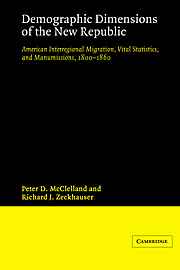 Demographic Dimensions of the New Republic
Demographic Dimensions of the New Republic Published online by Cambridge University Press: 19 September 2009
Overview 1800–60
The marked decline in the observed rate of growth of the American Negro population in the period 1800–60 has been a continual puzzle for historians and demographers. From a high of 38 percent in the decade 1800–10, the growth rate declined to 22 percent in the decade 1850–60. (See Table B-l.) ‘Neither demographic data nor contemporary accounts of living conditions satisfactorily explain why the growth rate tapered off.’ The explanation can only be in terms of falling immigration, rising death rates or declining birth rates. Section 3.6 indicated the tenuous nature of the historical evidence concerning the magnitude and trend of slave smuggling. Evidence on vital statistics is almost as elusive.
The birth rate of slaves was undoubtedly ‘high’ throughout the ante-bellum period. Historians have not infrequently claimed that their housing arrangements and loose family structure favored ‘widespread sexual promiscuity’, a tendency that was hardly discouraged by white owners who had, in the discreet wording of Ulrich Phillips, ‘everywhere and at all times an interest in the multiplication of their slaves’. This interest occasionally manifested itself in specific incentives offered to prospective mothers: labor exemptions during pregnancy sometimes with the added bonus of better food and clothing; in some cases, complete exemption from field work for women with six or more healthy children. Two conclusions follow.
To save this book to your Kindle, first ensure [email protected] is added to your Approved Personal Document E-mail List under your Personal Document Settings on the Manage Your Content and Devices page of your Amazon account. Then enter the ‘name’ part of your Kindle email address below. Find out more about saving to your Kindle.
Note you can select to save to either the @free.kindle.com or @kindle.com variations. ‘@free.kindle.com’ emails are free but can only be saved to your device when it is connected to wi-fi. ‘@kindle.com’ emails can be delivered even when you are not connected to wi-fi, but note that service fees apply.
Find out more about the Kindle Personal Document Service.
To save content items to your account, please confirm that you agree to abide by our usage policies. If this is the first time you use this feature, you will be asked to authorise Cambridge Core to connect with your account. Find out more about saving content to Dropbox.
To save content items to your account, please confirm that you agree to abide by our usage policies. If this is the first time you use this feature, you will be asked to authorise Cambridge Core to connect with your account. Find out more about saving content to Google Drive.